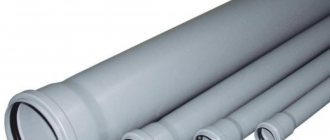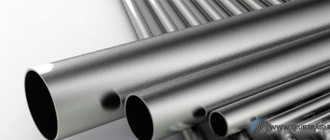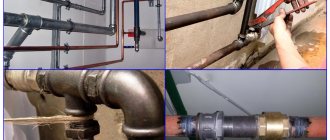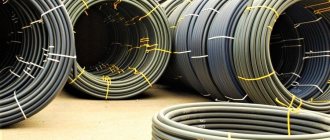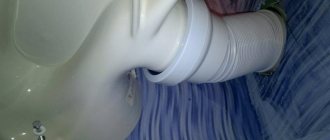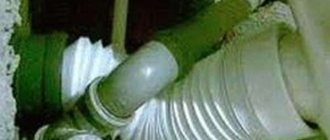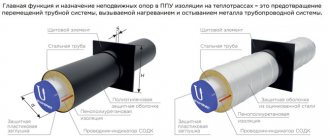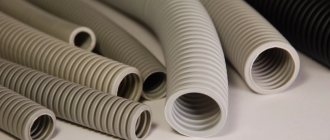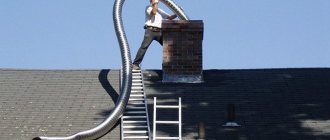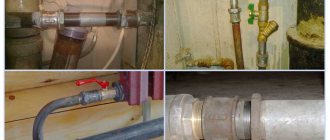In the modern world, new technologies and materials are becoming increasingly widespread, including in the laying of utility networks. Heavy and low-tech pipelines made of steel and cast iron are being replaced by polymer pipes that are lightweight and easy to install. Unlike metal networks, the polymer is not afraid of corrosion, is resistant to transported working media and has a relatively low weight, which is important for multi-story composite structures.
Polymer pipes are produced from two types of material - low-density polyethylene (aka HDPE - high-density polyethylene) and polyvinyl chloride. Each material has its own characteristics, and their purpose varies accordingly.
Rules for installing PVC pipes for electrical wiring with your own hands
Laying out an electrical network begins with a layout of sockets, automatic machines, lamps, switches, and connection points for stationary electrical equipment (stove, boiler, electric oven).
All power supply lines must run either vertically or horizontally, at a distance of 20 cm from the ceiling, floor, door, and distribution boxes must be installed at branching points. Regardless of the wiring installation method (behind a false wall, in grooves), there must be access to the boxes. Connecting wires is allowed only in junction boxes and under no circumstances inside the shell pipe.
When installing pipes for pouring into a screed or concrete wall, you must first securely secure the structure using metal clamps. When installing a pipeline in a groove in a brick wall, you can fix it with quick-setting plaster (alabaster) and then plaster it.
To install the pipe shell outdoors, metal clamps are used; inside the building, plastic clips are used.
During installation, any pipes must fit into the opening of boxes, sockets, switches; gaps between the box and the pipe are not allowed.
In damp rooms, outdoors and in the ground, sealed pipes are used for installing electrical wiring. At the joints of pipes and distribution boxes, special seals are used (you can additionally coat them with sealant, for example, silicone). When laying open communications in dry rooms, the use of seals is not necessary.
If the electrical wiring is installed near the heating system, then when crossing, the distance from the heating should be at least 5 cm, and if the pipes run parallel, then the distance should be at least 10 cm.
You cannot bend pipes with a small turning radius; when bending, you must comply with the standard radius and use a pipe bender or templates. There should be no cracks, folds, or creases at the bend site.
Required tools and materials
Tools required to perform work with corrugated hoses:
- Grinder with cutting disc.
- Hammer.
- Drill and screwdriver.
- Metal scissors.
- Construction knife.
Materials:
- Corrugated sleeve
- Clips or clamps.
- Dowels.
- Distribution boxes, boxes for sockets and switches.
- Electrical tape, scotch tape.
- Sealing gaskets, sealant.
- Perhaps a hard thin wire or a special broach.
Installation technology
The installation technology is quite simple:
- Cut the pipes or corrugation into pieces of the required length; when cutting the corrugation, you must ensure that the probe does not go inside the pipe.
- Securely attach the cable to the probe using tape or tape. The bent tip of the probe must be bitten off, otherwise when the cable is retracted it will damage the inner surface of the corrugation.
- Pull the cable into the tube. If several wires are pulled in, you need to tape them together several times with electrical tape.
- Mark the location of the cable in the casing and the places of fastenings.
- If necessary, punch a hole, secure the tube using clamps, clips, or alabaster. Fasteners must be installed at intervals of at least 50 cm and always near the boxes, at a distance of no more than 20 cm. The system can only be filled after the pipelines have been securely fastened.
- Mount boxes, tees, bends, connect to pipes, seal if necessary (install seals, lubricate with silicone).
Electrical installation in PVC pipes. Part 1.
Features of corrugated pipe installation
The corrugated pipe has very great flexibility - after installation it will sag slightly; it is necessary to frequently place clips or clamps. Do not tighten the corrugation too much during installation - this weakens its strength. When installing behind plasterboard or other facing materials, you cannot lay the corrugation obliquely - only vertically and horizontally. You can attach the corrugated hose to the frame structures for cladding. Do not lay corrugation through sharp corners on structures - it will quickly become damaged.
uPVC pipes (unplasticized polyvinyl chloride)
PVC began to be produced industrially back in 1931. During operation, this wonderful material was improved. The scope of its application has increased.
Of all polymers, uPVC is the most durable material, its elastic modulus is more than 3000 MPa.
In our country, uPVC has been used since the eighties of the twentieth century.
Currently, in Europe, well casing is made exclusively from uPVC; in our country, it began to be used for drilling private water wells in 1998; the implementation process was slow. The first wells using uPVC technology were made in 2011; to date, the condition of the wells is checked annually. Since the material has proven itself, such wells have been drilled en masse in the last 2-3 years.
Advantages of uPVC
- Durability over 60 years;
- The chemically inert material does not pollute the water supply and the surrounding environment;
- Resistant to electrochemical corrosion;
- High resistance to external pressure;
- Cost is lower than steel;
- Silences noise and vibration;
- No external steel jig required;
- Sockets at pipe joints provide high tightness and additional strength.
Disadvantages of uPVC
- Sensitivity to frost below 15°C;
- There is a limitation on the depth of use of such casing, no more than 120 meters;
- It is not always possible to line a well with a uPVC pipe in the case of complex geology of the site.
Important: it is worth mentioning separately about the wall thickness of uPVC pipes used for drilling water wells: diameter 125 mm - wall from 7.5 mm, diameters 140 mm and 170 mm - from 8 mm. Beware of offers of thin-walled pipes with a stack of 5 - 6 mm
When assembling casing columns for an artesian well, the following are taken into account:
- Drilling depth;
- The need for the amount of water (determines the diameter);
- Soil structure;
- In-situ water pressure in a specific area. Many complications arise when water flows out of a well;
- Groundwater height.
When looking for the best options, take advantage of the expertise in integrated water supply. The company's engineer always visits the site before work begins, and on site he will provide more detailed advice on the characteristics of the siege pipes, taking into account the characteristics of your area.
Order an engineer visit to draw up an autonomous water supply project by calling: (495) 649-8593
Detailed photo reports of projects completed by our specialists in the Moscow region. The final estimates and characteristics of the wells are given. Read more: more than 200 examples of our work
The quality of the arrangement of a personal source determines both its service life and the comfort of the entire system in the cottage. Read more: well construction
How often should the maintenance schedule be carried out for the autonomous water supply system in the house? List of necessary works. Read more: maintenance of the water supply system of a private house
Source
Where are PVC pipes used?
*
Using these products:
- Water supply systems are installed;
- Irrigation systems are being created;
- Free-flow sewerage is being laid;
- Storm drains are being installed.
PVC products come in two types: chlorinated and made from non-plasticized polyvinyl chloride.
The main advantage of the first type is the high melting point (more than +480 degrees Celsius). And thanks to the high mechanical strength, high-pressure pipelines are created from these products. Excellent resistance to aggressive media makes it possible to pump strong acids and other reagents through such systems. CPVC pipes are used when it is necessary to transport water, vegetable oil, juice or any other liquid food product.
uPVC products
Pipes made of non-plasticized plastic cope well with operating temperatures from 0 to +60 degrees Celsius, therefore they are suitable for transporting alkalis, acids and other aggressive liquids. They are safe for humans, so they also supply water.
No. 6. Manufacturers of corrugated pipes for electrical wiring
When purchasing corrugated pipes, it doesn’t hurt to inquire about the availability of quality certificates
This is not a mere formality, but an important security requirement. It doesn’t hurt to look at the name of the manufacturer, since large companies will not risk their reputation and produce products of inadequate quality
Among the largest manufacturers of corrugated pipes, whose products are presented in domestic stores, it is worth noting:
- LLC "is a domestic enterprise that produces and sells a wide range of materials for electrical wiring, incl. produces corrugated pipe. The range includes products made from PVC, HDPE and PP, light and heavy pipes, with and without a probe, of different diameters. Production is standardized according to ISO 9001, and products meet all European requirements;
- JSC "RUVINIL" is one of the largest Russian manufacturers of electrical products. Since 1998, the company has mastered the production of a huge range of products, using modern technologies and high-quality raw materials. The company produces corrugated pipes from PVC, HDPE and LDPE with a diameter of 16 to 63 mm;
- is another fairly large domestic company that produces a solid range of electrical installation products. Corrugated pipes here are made only from PVC, diameter from 16 to 55 mm, there are products with and without a probe, light and heavy;
- Delta LLC produces products under the EnergoPlast brand. The assortment includes PVC and HDPE pipes, light and heavy, with and without a probe;
- Tyumen Corrugated Pipe Plant produces PVC pipes of various diameters;
- NASHORN is a company that today is called one of the largest manufacturers of plastic pipes. For installation of electrical wiring, they only produce corrugated pipe made of PVC; the range is not very large.
Connection of PVC and HDPE pipes
The coincidence of standard sizes indicates that the connection of PVC and HDPE pipes is possible. Moreover, in many cases it is inevitable. For example, at connection points for indoor and outdoor sewerage networks. In addition to the production of pipes, GOSTs also provide for the production of standardized fittings and fittings for connecting parts of pipelines in different ways.
Answers to the question of how to connect a HDPE pipe to a PVC pipe immediately exclude two options - welding and adhesive connection. This is due to the physical properties of the materials. This situation is called incompatibility. Therefore, to connect parts of pipelines made of HDPE and PVC pipes, other methods provided for this case are used:
- for non-pressure pipelines - sockets for sealing rings;
- for pressure pipelines - fittings with mechanical fixation.
Both connection methods fully comply with the operating pressure for which the corresponding types of pipelines are designed, guaranteeing the tightness of the system as a whole. When connecting pipes made of the same types and brands of polymer materials, you can use all the methods presented in the table above. However, situations when you have to connect HDPE and PVC pipes do not happen often.
Advantages and disadvantages
HDPE pipes 32 mm have useful user characteristics.
- Corrosion resistance – products are not susceptible to rust or fungus, and do not require protective coatings.
- Inertness - the material is resistant not only to acid and alkaline solutions and cannot be destroyed, but also retains the primary composition of the supplied liquid.
- Smooth internal surface - does not allow the deposition of salts, mechanical debris, silt and the like. The working diameter of HDPE 32 mm does not change over time.
- Plasticity - when water freezes, a plastic pipeline, unlike a steel one, does not break or deform. A 32 mm HDPE water pipe can increase its volume by up to 8% under the influence of increased pressure, and then return to its original state after the liquid defrosts.
- The same property allows the use of polyethylene water conduits when laying in seismic active zones or simply unstable soils where movement is possible.
- Durability – up to 50 years.
- Installation is much easier and faster, since, firstly, the weight of the products is much less, secondly, the connection is simpler, and thirdly, the pipeline does not need waterproofing.
- The cost of a water supply or sewer system is much lower both due to the price of the material and due to the reduction in installation costs.
- The maximum temperature of the transferred liquid for 32 mm HDPE pipes is 40 C. This characteristic limits the scope of application.
- The material is not resistant to ultraviolet radiation, therefore, when organizing a water supply system, it is necessary to ensure that the system is placed only in shaded areas.
Installation technology
The connection is made in several ways depending on the purpose, length of the pipeline, operating conditions, etc.
Detachable connection - carried out using special elements - fittings. This method is recommended for HDPE pipelines of 32, 25, 20 mm, that is, with a small diameter. Fittings for HDPE pipes 32 mm are equipped with a sealing ring and a nut, and can be used several times. The detachable method ensures ease of repair and replacement in case of damage.
Source
Difference in area of use
In addition to different physical characteristics, the compared pipes have differences in their areas of use. PVC elements are in demand when installing household non-pressure sewerage systems, storm drains, drains and water supply systems. HDPE products are used for the installation of drainage systems, pressure sewers, for moving gas and protecting wires and cables. Polyethylene pipes are used for the construction of both drinking and technical water supply systems.
We recommend: Irrigation from pipes
uPVC pipes (unplasticized polyvinyl chloride)
PVC began to be produced industrially back in 1931. During operation, this wonderful material was improved. The scope of its application has increased.
Of all polymers, uPVC is the most durable material, its elastic modulus is more than 3000 MPa.
In our country, uPVC has been used since the eighties of the twentieth century.
Currently, in Europe, well casing is made exclusively from uPVC; in our country, it began to be used for drilling private water wells in 1998; the implementation process was slow. The first wells using uPVC technology were made in 2011; to date, the condition of the wells is checked annually. Since the material has proven itself, such wells have been drilled en masse in the last 2-3 years.
Advantages of uPVC
- Durability over 60 years;
- The chemically inert material does not pollute the water supply and the surrounding environment;
- Resistant to electrochemical corrosion;
- High resistance to external pressure;
- Cost is lower than steel;
- Silences noise and vibration;
- No external steel jig required;
- Sockets at pipe joints provide high tightness and additional strength.
Disadvantages of uPVC
- Sensitivity to frost below 15°C;
- There is a limitation on the depth of use of such casing, no more than 120 meters;
- It is not always possible to line a well with a uPVC pipe in the case of complex geology of the site.
Important: it is worth mentioning separately about the wall thickness of uPVC pipes used for drilling water wells: diameter 125 mm - wall from 7.5 mm, diameters 140 mm and 170 mm - from 8 mm. Beware of offers of thin-walled pipes with a stack of 5 - 6 mm
When assembling casing columns for an artesian well, the following are taken into account:
- Drilling depth;
- The need for the amount of water (determines the diameter);
- Soil structure;
- In-situ water pressure in a specific area. Many complications arise when water flows out of a well;
- Groundwater height.
When looking for the best options, take advantage of the expertise in integrated water supply. The company's engineer always visits the site before work begins, and on site he will provide more detailed advice on the characteristics of the siege pipes, taking into account the characteristics of your area.
Order an engineer visit to draw up an autonomous water supply project by calling: (495) 649-8593
Detailed photo reports of projects completed by our specialists in the Moscow region. The final estimates and characteristics of the wells are given. Read more: more than 200 examples of our work
The quality of the arrangement of a personal source determines both its service life and the comfort of the entire system in the cottage. Read more: well construction
How often should the maintenance schedule be carried out for the autonomous water supply system in the house? List of necessary works. Read more: maintenance of the water supply system of a private house
Modern technologies affect all areas of our lives. Pipeline systems that are used for water supply, sewerage, drainage, and heating have not been left out. And if previously all pipes were made of various metals and alloys, now HDPE and PVC pipes are becoming increasingly popular, outperforming their steel counterparts in almost all respects.
What are the differences between HDPE and PVC? Which pipes will last longer and which ones are stronger? Our article is devoted to the consideration of these issues.
HDPE pipe is made from low-density polyethylene. Depending on the manufacturing method, there are two main types: non-pressure (low pressure) and pressure (medium pressure). There is also a separate class - LDPE high-pressure polyethylene pipes.
Question for backfilling: semiurg
A question for those who really know.
In the UAZ, I am going to lay the wiring in flexible plastic sleeves - for reliability and aesthetics. In this regard, I had a question - there are two types of corrugations for cables - PVD and PVC. Black and gray, respectively, are made of HDPE (low-density polyethylene) and non-flammable PVC (polyvinyl chloride) composition. Gray PVC is cheaper, but I read on various forums that only black HDPE should be used in cars. No explanation, unfortunately.
Having dug into the specifications, I did not find any fundamental difference between “Flexible corrugated pipes made of HDPE (corrugated pipe)” and “Flexible corrugated pipes made of PVC” . There is a difference in the temperature range - 45 degrees PVC and 90 degrees HDPE, but this is important only in the engine compartment, and the largest footage will go along the frame under the bottom. And the difference in price, meanwhile, is more than double.
So, are there any among you who understand the subject? Is there a difference between HDPE and PVC corrugation that is fundamental for use in a car? Well, maybe it’s gasoline-oil resistance, or something else that’s not obvious? Well, besides the fact that black looks cooler?
And one more thing - what is the best way to seal the entrances/exits (terminations) of the corrugations? Well, electrical tape - of course - but maybe there is something specially designed for this?
The original of this entry is at https://semiurg.ru/2011/05/28/vopros-na-zasypku/ When copying materials, please refer to the original, and not to the LiveJournal broadcast.
semiurg.livejournal.com
Kinds
Corrugations for wires are available in several dozen types. The articles of this special product differ in color, material of manufacture, diameter, load-bearing capacity, and wall thickness. Let's look at the types of corrugated pipes:
By material
- Polyvinyl chloride (PVC). Used as non-flammable and inexpensive cable protection products that must be located away from exposure to sunlight, water and ultraviolet radiation.
- Metal (metal hoses). Protect from mechanical damage, fires, corrosive and other active substances.
- Polyethylene, polypropylene (PPR). They can be intended for installation under conditions of high (HPE) or low (HDPE) pressure, withstand temperature influences from – 40 ° C to + 45 ° C, as well as exposure to acids, alkalis, ultraviolet rays and oils (PPR pipes are self-extinguishing and usually are painted gray during manufacturing, HDPE – orange or black).
Polyethylene corrugationSource elektro-svitidla.com
In terms of resistance to external influences
- Lightweight (wall thickness up to 320 N/5 cm², flexible, cannot withstand heavy loads) are laid in ceiling and wall plasterboard structures.
- Medium ones (wall thickness up to 750 N/5 cm²) can be placed in the grooves of room walls.
- Heavy (wall thickness up to 1250 N/5 cm², are inflexible) can withstand installation in concrete screeds, withstand exposure to moisture, dust and dirt.
- Reinforced super-heavy (the thickness of the walls of the metal corrugation for electrical wiring is more than 1250 N/5 cm², it consists of metal wires twisted in a spiral, covered with a plastic sheath) intended for installation outdoors or underground.
By number of layers
- Single-layer (may have different thicknesses).
- Double-layer (have two walls at once).
Metal corrugation, in turn, is divided into several subspecies. It can be made from stainless or galvanized steel; plastic or polymer material is used as a coating. Metal-polymer corrugated hose has the best user characteristics, as it maximally protects wires from water and dust.
Laying metal corrugationSource rusenergetics.ru
The outer diameter of corrugated cable products can range from 16 mm to 87.5 mm, the inner diameter - from 5 mm to 78 mm. Also, the design of some corrugated pipes includes a probe that helps pull flexible wires through the sleeve.
According to GOST R IEC 61386, several types of corrugated hoses are distinguished: according to the degree of spread of the combustion process, and according to protection against corrosion. According to the rules of GOST 14254-2015, the degree of protection of corrugated pipes from penetration and exposure to solid particles and/or water is indicated according to the IP index. Corrugated highways are also divided into several types according to the temperature range at which they can be operated. When choosing a specific type of corrugation, a specialist must be guided by information about the use and location of the wiring being laid.
Laying in groovesSource uk-parkovaya.ru
For example, outdoors it is imperative to use a protected reinforced corrugated pipe, which resists the effects of mechanical, natural, and temperature factors and has an IP rating corresponding to the expected load.
Size
The thickness of the corrugated cable determines the number and thickness of wires that can be laid through such a protective sleeve. When a corrugated pipe is sold, it is marked in which the first number indicates the outer diameter, the second - the wall thickness. The diameter of the cable corrugation is indicated in the table:
This is how the thickness of the corrugation is determined (table, part 1) Source infocable.by
This is how the thickness of the corrugation is determined (table, part 2) Source infocable.by
Here are a few examples to improve your understanding of the process of correctly selecting corrugated hoses for various types and types of cable (wires):
- 16 mm - pipes with this thickness are suitable for laying two wires from the electrical distribution panel to the lighting fixtures;
- 20 mm - this corrugation is suitable for running cables to sockets and switches;
- 25 mm - this thickness of corrugated pipe is ideal if it is necessary to run cables from the electrical panel to another component of the electrical circuit;
- 32 mm - such a thick sleeve helps to lay the cable from one shield to another;
- 40 mm and thicker - this corrugation is used for laying wiring in interfloor coverings.
Device
A corrugated HDPE pipe is a hollow channel, the walls of which are made up of evenly alternating sections of varying thickness. The wall can be single-layer, structured on the outside and inside of the product, or two-layer with a smooth inner and ribbed outer surface.
Specifications
This type of corrugated pipes is produced by extrusion from a high-density polymer obtained by the low-pressure polymerization of ethylene (LDPE).
The finished product, depending on the series, has the following technical characteristics:
| No. | Indicator name | Series | |
| Lightweight | Heavy | ||
| 1 | Classification code according to EN 61386-1 and EN 61386-23 | 1342 | 2442 |
| 2 | Degree of protection | IP55 | |
| 3 | Permissible installation temperature range | From -40 ºС to +90 ºС | |
| 4 | Range of permissible operating temperatures | From -40 ºС to +90 ºС | |
| 5 | Strength index | Over 125 N per 5 cm | Over 320 N per 5 cm |
| 6 | Color number according to RAL catalog | 2004 (orange), 7021 (black) | |
| 7 | Minimum bend radius | 3 diameters | |
| 8 | Insulation resistance | Not less than 100 MOM | |
| 9 | Protection class | 0 according to GOST 12.2.007.0 |
PVC-U polymer pipes
uPVC is an alternative to metal pipes. They are made of dense, unplasticized polyvinyl chloride. Unlike HDPE, they are used as the main casing pipe. The first wells using uPVC were drilled back in 2011. We are constantly studying this process. Since 2021, based on experimental data, our company began to widely use them in its work. Photo 1 shows uPVC pipes.
Advantages of uPVC
- Durability. A well using uPVC pipes can operate for more than 50 years.
- Resistance to electrochemical and galvanic corrosion. uPVC consists of polyvinyl chloride. Simply put, it is a polymer (plastic) that does not corrode.
- Strength. UPVC products are manufactured by continuous extrusion from unplasticized polyvinyl chloride. The material is strong and environmentally friendly.
Ours uses uPVC in its work in accordance with GOST P 51613-2000.
HDPE is a low-pressure polyethylene pipe. It is used as an additional (internal) column in two-pipe well structures. HDPE is not strong enough to be used as a main column. They are mounted inside metal or uPVC.
Application of polymer products
PVC, based on its characteristics, is used to create non-pressure and pressure networks in constant temperature conditions, in warm climates, indoors and in basements; this material is absolutely not suitable for creating a utility network outside the house.
The choice in favor of HDPE pipes is more democratic, pressure or non-pressure pipeline, any temperature range, but at the same time, you should not use products made from recycled polyethylene to provide drinking water. Its use is somewhat limited only by the complexity of the connection, but at the same time, when using electric welded couplings, these inconveniences can be reduced to a minimum.
Material properties
Pipes of this segment are produced from polyethylene using low or high pressure in strict accordance with technical requirements. This allows us to ensure that the HDPE corrugated cable:
- Can withstand different temperature fluctuations.
- Easy to install.
- It has very high flexibility - up to 360 0.
- High fire resistance against possible short circuits in the network: GOST R50827 with a degree of protection of ip55.
- The two-layer type contains a special additive that protects the material from the combustion stage, remaining at the stage of gradual melting.
- There is no need for additional fittings.
- Absolute inertness - the material does not react in any way with the media of use.
- Grounding is not required, the electrical HDPE pipe is completely dielectric.
Specifications
Corrugated HDPE hoses are not regulated by GOST standards. They are produced according to specifications taking into account the following technical characteristics:
| Installation work can be carried out in a temperature range | -40…+90 0 С |
| Operating temperature range | -40…+90 0 С |
| Strength | more than 350N |
Physical and chemical properties
Single-wall HDPE corrugation is made, as well as double-wall corrugation from polyethylene obtained under low pressure. This is a high-quality plastic with unique physical and chemical properties. Produced in strict compliance with technology and standards, the resulting plastic is an environmentally friendly product. They perfectly protect communications from damage. Endowed with all the positive properties mentioned above.
corrugated HDPE or PVC which is better
Love Sport
- Contact Us
Toggle navigation
- Highlights sport
- Highlights Olympics
- Highlights football
- Highlights champions league
- Highlights AFF Championship
- Highlights Seagame
- Champions League
- Skateboarding News
corrugated HDPE or PVC which is better – Love Sport
loading…
- corrugation mon
- corrugated HDPE
- corrugated HDPE or PVC
- corrugated HDPE and PVC difference
- th
sportlove.info
HDPE PIPES (low pressure polyethylene)
They are used when installing water supply systems for cold water (HDPE pressure pipe for drinking water), and are also used when installing pressure sewer systems. Cannot be used in hot water supply and heating systems.
Low-density polyethylene (LDPE) and high-density polyethylene (LDPE) - what are the differences?
In short: LDPE is a low-density material obtained by the polymerization of ethylene at elevated pressure. Melting point is about 110°C. LDPE pipes are usually intended for installation of free-flow (gravity) sewerage and as a shell for laying electrical communications. A wide range of products are made from it - bags and packaging film, pipes, insulation of high-voltage electrical cables, tanks and canisters, furniture fittings, etc. HDPE has a higher density and better strength characteristics compared to LDPE.
The melting point is about 130°C, which is 20° higher than that of LDPE. The moisture and gas permeability of HDPE is 5 times lower than that of LDPE, it has greater chemical resistance to fats and oils. Typically, this type of pipe is used for external installation of cold water supply pipelines. HDPE pipes are currently made from PE-100 grade polymer, which replaced PE-80. Such polyethylene pipes can also be recommended for the installation of pressure sewerage. The main use of HDPE pipes is external installation for cold water supply, and non-reinforced polypropylene pipes - internal, because HDPE pipes can withstand lower temperatures, and they do not look suitable for installation inside an apartment. Most often, the pipe is produced in black and has a blue stripe along its entire length, which means it is suitable for use with cold water.
Advantages of HDPE and LDPE polymer pipes:
- have a long service life - at least 50 years;
- do not require cathodic protection when laying in the ground, because not subject to electrochemical corrosion;
- with equal characteristics, the cost of polyethylene pipes is lower than steel;
- the internal diameter of the pipes does not change over time, because the inner surface is smooth and scale does not deposit on it and biological deposits do not accumulate;
- heat loss and the degree of condensation formation on the outer surface are extremely small, because plastic pipes have low thermal conductivity;
- HDPE pipes, if the liquid inside freezes, will not burst, because the diameter of the pipe can increase under the pressure of frozen water by 5–7% and will return to its previous diameter after thawing;
- the weight of the pipes is 6 times lower than the weight of steel pipes of the same diameter and maximum operating pressure, which greatly facilitates transportation and installation;
- high resistance to water hammer (low modulus of elasticity of HDPE pipes);
- welding polyethylene pipes is much simpler, faster and cheaper than steel pipes, welded joints of HDPE pipes are reliable throughout the entire period of their operation;
- polyethylene pipes are approved for use in systems supplying drinking water and are completely environmentally friendly.
- resistance to low temperatures from -50°C and below.
Disadvantages of HDPE and LDPE pipes:
- cannot be used in heating and hot water supply systems, operating temperature is about 45°C, with a short-term increase to 80°C;
- installation using specific technology;
- less mechanically stable compared to steel and cast iron pipes. the service life of polymer pipes laid in the ground depends on the mobility of the soil;
- their performance characteristics are reduced under the influence of ultraviolet radiation (the degree of resistance to ultraviolet radiation depends on the catalysts used in the production process of HDPE granules).
- are susceptible to cracking under environmental influences, however, high-molecular grades of HDPE products do not have this drawback.
Corrugated HDPE or PVC for wiring, which is better?
- Registration: 05/16/14 Messages: 74 Thanks: 28
PVC or HDPE corrugated wiring?Good afternoon
The engineers and consultants blew my mind. Opinions differed diametrically. The essence of the problem is that VVGng-LS cables need to be laid inside the house on a concrete foundation slab. Cover the top with extruded polystyrene foam, then lay heated floor pipes and make a screed. Designers believe that HDPE corrugation is needed to lay the cable. The consultants at Minimax disagreed - one says that light PVC will be enough, the second says only HDPE, the third says only heavy HDPE. The website of the manufacturer DKS generally states that 1. Light HDPE pipe can withstand 12.5 kg/5 cm2 Heavy HDPE pipe can withstand 32 kg/5 cm 3. Light PVC pipe can withstand 35 kg/5 cm 4. Heavy PVC pipe can withstand 75 kg/5 cm And HDPE pipes spread combustion, so their scope of application is limited to hidden installation in non-combustible materials. PVC pipes do not propagate combustion and have fire safety certificates.Obviously, concrete is not a flammable material, but polystyrene foam is flammable...
It is clear that one of my interlocutors is incompetent. But who?
I would be grateful for your advice.
- Registration: 04/10/13 Messages: 782 Thanks: 357
Expanded polystyrene is flammable.
There is also a non-flammable one.
I think we need such a pipe so that during work the corrugation with the cable will not be pushed through. It was possible to replace the cable if necessary. Point 3.4 remains.
- Registration: 07/11/11 Messages: 10.325 Thanks: 11.445 Ivanov Kostya Practicing electrician
@Ksu ksu, polystyrene foam will not be able to burn in such conditions.
He simply doesn't have enough oxygen. The only danger remains mechanical damage to the cable when installing other floor layers. It all depends on the type of work and on the types that will perform the work associated with laying the PPS and subsequent ones. In other cases, you can use corrugated material, and sometimes it is better to use rigid HDPE. - Registration: 05/16/14 Messages: 74 Thanks: 28
There is also a non-flammable one. I think we need such a pipe so that during work the corrugation with the cable will not be pushed through. It was possible to replace the cable if necessary. Point 3.4 remains.
Replacing the cable in an option like ours is beyond fantasy, I think
Kostya Ivanov said:
↑
@Ksu ksu, polystyrene foam will not be able to burn in such conditions. He simply doesn't have enough oxygen. The only danger remains mechanical damage to the cable when installing other floor layers. It all depends on the type of work and on the types that will perform the work associated with laying the PPS and subsequent ones. In other cases, you can use corrugated material, and sometimes it is better to use rigid HDPE.
Thank you! As a result, we took ordinary PVC; previously, cables had been laid in HDPE underground. Here we decided to make do with PVC.
- Registration: 05/07/14 Messages: 7.225 Thanks: 7.300 GBS electrik I'm Kostyan from Chelyabinsk, if you don't recognize me.
Kostya Ivanov said:
↑
expanded polystyrene will not be able to burn in such conditions. He simply doesn't have enough oxygen.
The oxygen that is inside this polystyrene foam is sufficient for combustion.
- Registration: 07/11/11 Messages: 10.325 Thanks: 11.445 Ivanov Kostya Practicing electrician
GBS electric said:
↑
The oxygen that is inside this polystyrene foam is sufficient for combustion.
I carried out tests. Does not burn. More smoke than oxygen...
- Registration: 11/21/13 Messages: 3,904 Thanks: 3,753
ZooZoo
I am somewhere in Moscow time. Not on Mars for sure.
ZooZoo Blocked I am somewhere in Moscow time. Not on Mars for sure.
Kostya Ivanov said:
↑
More smoke than oxygen...
How did you determine?
- Registration: 07/11/11 Messages: 10.325 Thanks: 11.445 Ivanov Kostya Practicing electrician
How did you determine?
Visually.
- Registration: 08/22/17 Messages: 1 Thanks: 0
Electrical engineers, please give me some advice - for the second week I think I've lost my mind - what is better to use: HDPE or PVC in a wooden building for external wiring?
- Registration: 05.15.12 Messages: 956 Thanks: 331
HDPE or PVC in a wooden building for external wiring?
Maybe it's better in a metal pipe?
- Registration: 05/07/14 Messages: 7.225 Thanks: 7.300 GBS electrik I'm Kostyan from Chelyabinsk, if you don't recognize me.
HDPE or PVC in a wooden building for external wiring?
Why do you need wiring outside the house? It's not practical
- Registration: 06/05/17 Messages: 2,501 Thanks: 1,466
Electrical engineers, please give me some advice - for the second week I think I've lost my mind - what is better to use: HDPE or PVC in a wooden building for external wiring?
What do you understand by the word “external”?
Good day to our regular and new readers! Today we will talk about what corrugated HDPE and PVC are, what is the difference between them, how to choose material for different purposes and what are the advantages of each type and its features in relation to operating conditions.
What is HDPE and PVC
The word “corrugation” is commonly used to describe corrugated plastic hollow pipes into which electrical cables are “packed” and laid for a variety of purposes not only indoors, but also outdoors. The corrugated wall of such a pipe has incomparably greater flexibility than a smooth plastic tube of the same diameter and with the same wall thickness. This is very helpful when laying electrical networks of complex configurations.
The two most common and popular varieties among consumers are HDPE (low-density polyethylene, and sometimes high-density LDPE) and PVC (polyvinyl chloride). Both have the widest application, but for a specific type of wiring it is customary to choose a certain type of corrugation, focusing on its characteristics, advantages, disadvantages and cost.
Both PVC and HDPE are not semiconductors (SC), but full-fledged insulating materials.
Characteristics and scope
Both types are used for:
- Installation of wiring in walls made of flammable materials (wood), or behind finishing made of such materials, as well as when attaching cables to wooden floors to increase fire safety;
- Protecting the cable from mechanical damage (the harder the corrugation, the better), moisture penetration;
- Protection of the cable from compression when installing “warm floor” systems under a concrete or semi-dry screed; in the future, the damaged cable can be easily replaced without breaking the screed;
- Preventing cable damage from the sun and moisture when laying it outdoors.
PVC corrugation is light and flexible, so it is purchased for installing wiring in the most inaccessible places, and after installation, the line can be sealed with concrete. It is also used for installing ceiling lighting systems hidden behind decorative finishing panels made of plastic, plasterboard, etc. Since the own weight of the corrugation is very small, you can use a minimum of fasteners for light pipes or do without them at all.
Optimal operating mode at a temperature of +25-60 0C. Corrugation is almost never used for external laying due to its rather narrow operating temperature range.
HDPE is more resistant to fire, since for this material the operating temperature range has a much larger range of +40-900 0C. These pipes are heavier.
HDPE corrugation does not pose an environmental hazard, since it itself does not emit harmful substances, but it is not destroyed by the effects of gasoline, acids, or oils.
This type is ideal for outdoor installation.
Advantages and disadvantages
Among the advantages related to both types of corrugation are:
- Durability: the service life of corrugated electrical wiring is at least 50 years, and in optimal conditions – much longer;
- Protection of wiring from overheating, cables sticking together, abrasion;
- No need to think about grounding;
- Insulation from moisture;
- A steel broach inside the corrugation helps speed up installation;
- Due to corrugation, you can abandon expensive cables and use more affordable ones.
PVC corrugated material is valued for its excellent insulating properties. Its use helps to avoid the induction of stray currents, which makes it possible to lay several cables with different technical parameters inside one pipe at once.
What are the differences, and which corrugated pipes are better?
PVC corrugation is produced predominantly in gray color, so it is easy to distinguish it from others both in the lining and in the store window. It has the valuable property of self-extinguishing, which is very important when installing particularly critical networks with increased fire safety requirements. The moisture resistance of this type of corrugation is not too high, inferior to analogues from other materials. Preferred scope of application: residential and industrial premises with a normal level of air humidity (50-60%).
Polyethylene pipes come in different colors: orange, black. Polyethylene itself is flammable and, in comparison with PVC, is not resistant to water and aggressive chemical influences. It is this type of corrugation that is chosen for the installation of electrical networks in concrete screeds, grooves inside plaster and other non-combustible materials, for laying open wiring outdoors, that is, for the street.
The differences between the two varieties are quite serious, so they cannot be said to be 100% interchangeable.
Conclusion
Our comparison showed that it is impossible to say which corrugation is better, since each has its own niche. For the buyer, price matters. According to this indicator, PVC is cheaper, and HDPE can be classified in the middle price segment. The quality of the product is indicated by the uniform color of the pipes, as well as the same wall thickness throughout.
On sale you can find corrugation with a diameter of 16-65 mm. The size for a specific application is chosen so that after laying the cable there remains a gap equal to half the radius of the corrugation inside. This requirement is dictated by concerns about fire safety, since the absence of an air gap if any cable overheats can cause a fire in the entire pipeline.
We say goodbye to you, we hope that the information will be useful to you and will be useful in practice. Leave reviews and comments, and don’t forget to check out our pages on social networks to find out news and share your opinion! Bye bye!
otoplenie-help.ru
